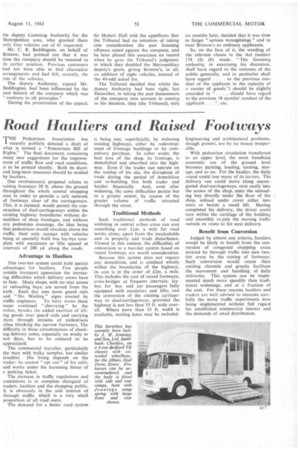Road Hauliers and Raised Footways
Page 51

If you've noticed an error in this article please click here to report it so we can fix it.
THE Pedestrians Association has recently publicly debated a draft of what is termed a "Pedestrians Bill of Rights." The final document, containing many new suggestions for the improvement of traffic flow and road conditions, is to be printed shortly. Both its shortand long-term measures should be studied by hauliers.
One revolutionary proposal relates to raising footways 20 ft. above the ground throughout the whole central shopping area in order to provide a safe network of footways clear of the carriageways. This, it is claimed, would permit the construction of dual-carriageways within the existing highway boundaries without demolition of shop frontages, and without any pedestrian crossings, the idea being that pedestrians would circulate above the traffic, their only contact with vehicles being at specially built bus lay-bys complete with escalators or lifts spaced at intervals of 200 yd. along the roads.
Advantage to Hauliers
This two-tier system could hold special advantages for hauliers. Few people outside transport appreciate the increasing difficulties which delivery crews have to face. Many shops, with no rear access or unloading bays, are served from the kerb. Each day sees more guard rails and "No Waiting" signs erected by
traffic engineers. To lorry crews these mean continual "chivvying" by the police, besides the added exertion of lifting goods over guard rails and carrying them through streams of pedestrians often blocking the narrow footways, The difficulty in these circumstances of checking delivery notes. especially on windy or wet days, has to be endured to be appreciated.
The commercial traveller, particularly the man with bulky samples, has similar trbubles. His living depends on the trader: he cannot "opt out" of his calls. and works under the harassing threat of a parking ticket.
The increase in traffic regulations and restrictions is in complete disregard of traders, hauliers and the shopping public. It is obviously in the sole interest of through traffic. which is a very small proportion of all road users.
The demand for a better road system
is being met, superficially, by widening existing highways, either by redevelopment of frontage buildings or by compulsory purchase. In either event, the best area of the shop, its frontage, is demolished and absorbed into the highway. Even if the trader can operate on the residue of his site, the disruption of trade during the period of demolition and re-building hits both trader and haulier financially. And, even after widening, the same difficulties persist but to a greater extent, by reason of The greater volume of traffic attracted through the street.
Traditional Methods
Such traditional methods of road widening in central urban areas can cost something over f4m. a mile for road works alone, apart from the incalculable cost in property and trade disturbance. Viewed in this context, the difficulties of conversion to a two-tier system based on raised footways are worth consideration.
Because this system does not require any demolition, and is confined wholly within the boundaries of the highway. its cost is in the order of £2m. a mile. This includes the cost of raised footways; cross-bridges at frequent intervals; laybys for bus and car passengers fully equipped with escalators and lifts; and the conversion of the existing carriageway to dual-carriageways, provided the highway is not less than 55 ft. wide overall. Where n-torc than 55 ft. width is available, waiting lanes may be included.
Engineering and architectural problems, though present, are by no means insuperable.
With pedestrian circulation transferred to an upper level, the most beneficial economic use of the ground level becomes parking, loading, turning, storage, and so on. For the haulier, the daily round could lose many of its terrors. The delivery van could move along uncongested dual-carriageways, turn easily into the access of the shop, enter the unloading bay directly under the floor of the shop, unload under cover either into store or beside a small lift. Having completed his delivery, the driver could turn within the eurtilage of the building and smoothly re-join the moving traffic outside en route to his next delivery.
Benefit from Conversion
Judged by almost any criteria, hauliers would be likely to benefit from the conversion of congested shopping areas severed by through traffic into new twotier areas by the raising of footways. Such conversion would retain their existing clientele and greatly facilitate the movement and handling of daily deliveries. This system can be implemented much more speedily than traditional widenings, and at a fraction of the cost. For these reasons hauliers and traders are well advised to examine carefully the many traffic experiments now being implemented without full regard for established commercial interest and the demands of retail distribution.




















































































































